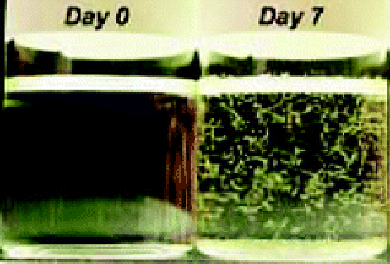US chemists writing in the Journal of Organic Chemistry report the room temperature reactions and the products formed by the reaction of dichloromethane (DCM) solvent with pyridine derivatives. Pyridine compounds are commonly used in alcohol protection reactions and acylation, Dess-Martin oxidation, and ozonolysis, but, the team warns, even under ambient conditions bispyridinium dichlorides can form. This could affect various organic reactions, leading to side-products, reduced yields, and spurious analytical results.
Chemists Alexander Rudine, Michael Walter, and Carl Wamser of Portland State University, in Portland, Oregon, USA, were undertaking electrochemical studies using DCM as a solvent and pyridine as an acid scavenger when they noticed that their stock solutions were generating fine white crystals, later identified as 1,1′-methylenebispyridinium dichloride.
Puzzled, the team searched the literature and found that reactions of DCM with primary, secondary, and tertiary aliphatic amines were well reported, but the analogous reactions with pyridine derivatives at room temperature and pressure were not known. There is a report of a high-temperature, high-pressure reaction of DCM with pyridine itself. Moreover, the higher reactivity of dibromomethane and diiodomethane is also known and in 1999, another team reported the synthesis of unsymmetrical bispyridinium derivatives from a halomethyl pyridinium derivative and a dissimilar pyridine.
.gif)
Intrigued, the team has now looked at the reactions of a series of pyridine derivatives with DCM. They studied thirteen different pyridine derivatives in DCM using proton nuclear magnetic resonance spectroscopy and watched for new downfield aromatic proton signals as well as the appearance of the “distinctive methylene signal”. They used carbon-13 NMR, infrared, Ultraviolet-Visible spectroscopy to further characterize the products in addition to high-resolution mass spectrometry.
In order to figure out what mechanism might be at play, the team also investigated the kinetics of the reaction between 4-(dimethylamino)pyridine and DCM and determined the second-order rate constants for the first (k1 ) and second (k2 ) substitutions as 2.56(±0.06) × 10-8 and 4.29(±0.01) × 10-4 M-1 s-1 , respectively. The kinetics implies a proposed mechanism involving two consecutive SN2 substitution reactions. The team adds that the second substitution is a lot more rapid than the first, which meant the mono-substituted product could not be isolated or detected in situ. In order to observe its kinetics the team had to synthesize that compound independently.
“One of the 3- and all of the 4-substituted pyridines studied reacted to form bispyridinium adducts,” the team reports, “thus in those cases caution is necessary whenever they are used with DCM.” They add that DMAP (4-dimethylaminopyridine) reacts fastest of the six derivatives studied and the product of that reaction does not precipitate out from the DCM solvent and so is especially problematic.
“For those who think that the reactions are too slow to be of concern, if the compounds are mixed directly before use, I think that’s correct,” Wamser told ChemViews. “However, if one attempts to store a stock solution of pyridine in DCM, you’ll get the crystals we found. There is one report of this problem arising when recrystallizing a product from DCM with pyridine present.”
Pericles Stavropoulos and colleagues at Boston and Harvard Universities, observed and briefly reported the reaction of DCM and pyridine at room temperature, while working on Gif chemistry, which was largely done in pyridine. “I was very surprised by this result,” Stavropoulos told Chemistry Views, “but never had enough time to study it in detail.” He was curious as to whether the process might be catalyzed by metallic impurities and was glad to see Wamser’s report providing a detailed explanation of the possible mechanism. “DCM and pyridine are common solvents,” adds Stavropoulos, “hence any reactivity between them needs to be well documented otherwise work done in this solvent mixture may be misinterpreted.
- Reaction of dichloromethane with pyridine derivatives under ambient conditions
A. Rudine, M. Walter, C. Wamser,
J. Org. Chem. 2010.
DOI: 10.1021/jo100276m - Functional Aspects of Gif-Type Oxidation of Hydrocarbons Mediated by Iron Picolinate H2O2-Dependent Systems: Evidence for the Generation of Carbon- and Oxygen-Centered Radicals
S. Kiani, A. Tapper, R. Staples, P. Stavropoulos,
J. Am. Chem. Soc. 2000, 122 (31), 7503–7517.
DOI: 10.1021/ja000063h




